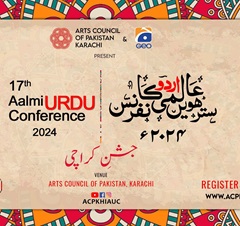Written by: Nageen Shaikh
Posted on: May 11, 2017 | 
'Just Me and Her' - Amna Rahman
It is interesting and oftentimes essential to examine an artist’s works by following the trajectory that he or she has pursued, culminating in the final piece that hangs in the art gallery. And it is even more fascinating when an artist shows depth, maturity and introspection in their first professionally exhibited works. Six fresh university graduates have showcased their work at the Sanat Initiative Gallery in a show titled Department Store, curated by Muhammad Zeeshan. While I found all of the works engaging and communicative, I will particularly discuss the work of Amna Rahman, Saddam Murad and Muzammil Khan, which I found to be outstanding.
Amna paints fearlessly with a liberty that unfortunately our society fails to appreciate or bestow on individuals who desire freedom of expression. Coming from her personal space and coalescing with the social norms surrounding us, her artworks establish a dialogue with the viewer by unraveling many layers. Amna’s work depicts the relationship that women have with other women. Within the vast landscape of feminine space, the two exhibited paintings, titled Just Me and Her and Love Interrupted explore friendship, sexuality, loyalty and trust. In an oxymoronic manner, the paintings seem very silent, yet are screaming to be heard, to be interpreted and comprehended. Being one of the two girls painted in Just Me and Her, the visage of Amna and her companion shows tension, but also a level of comfort that the two seem to share quietly. I laud her efforts in not only skillfully painting portraits, but also highlighting the feelings that women often silently experience in our society but tend to ignore.
Saddam Murad makes use of large canvases with representational but silhouetted and semi-abstract works in monotones. They seem to be dissolving into the backdrop – a strange but aesthetically pleasing quality that drew me to his paintings. Upon further examination, I found that the surface had been treated to a somewhat rough texture, which gave further insight into the artist’s intention: depicting the mistreatment of the female sex due to the pervasive spread of patriarchy. A comparison between Saddam and the late modernist master Sadequain immediately struck me upon first viewing his paintings, especially when it comes to using monotone hues with a man and woman as the subject. One of the paintings is a diptych that shows a woman facing a man in a personal setting. This can be interpreted as a place where the woman is treated as inferior to the man. Another one shows a faceless man and woman in the nude, seated side by side, yet highly separated in terms of socio-economic opportunity and equality.
Muzammil Khan layers his canvas with scenes of his used-to-be home when it was undergoing demolition. He tries to hold on to the times he spent so lovingly under that roof, which unfortunately is nothing more than a memory in his mind. Possessing an architectural quality in his drawing, Muzammil’s works are realistic and nostalgic.
Noshad Ali, Salman Khan and Jazib Jacob have produced excellent works of non-figurative painting. Salman paints his canvases in shades of grey, portraying his sentiments on the growing violence in the world today. Jazib layers his canvas and paper with ink and charcoal to give a microscopic effect, outlining his interest in chemical change and metamorphosis. Finally, Noshad Ali makes use of geometric patterns in grey, giving way to abstraction, a style that features throughout this particular exhibition. The show continues till May 18, and is definitely worth a visit.
You may also like:

17th Aalmi (International) Urdu Conference, Jashn-e-Karachi: A Resounding Success
(December 10, 2024)